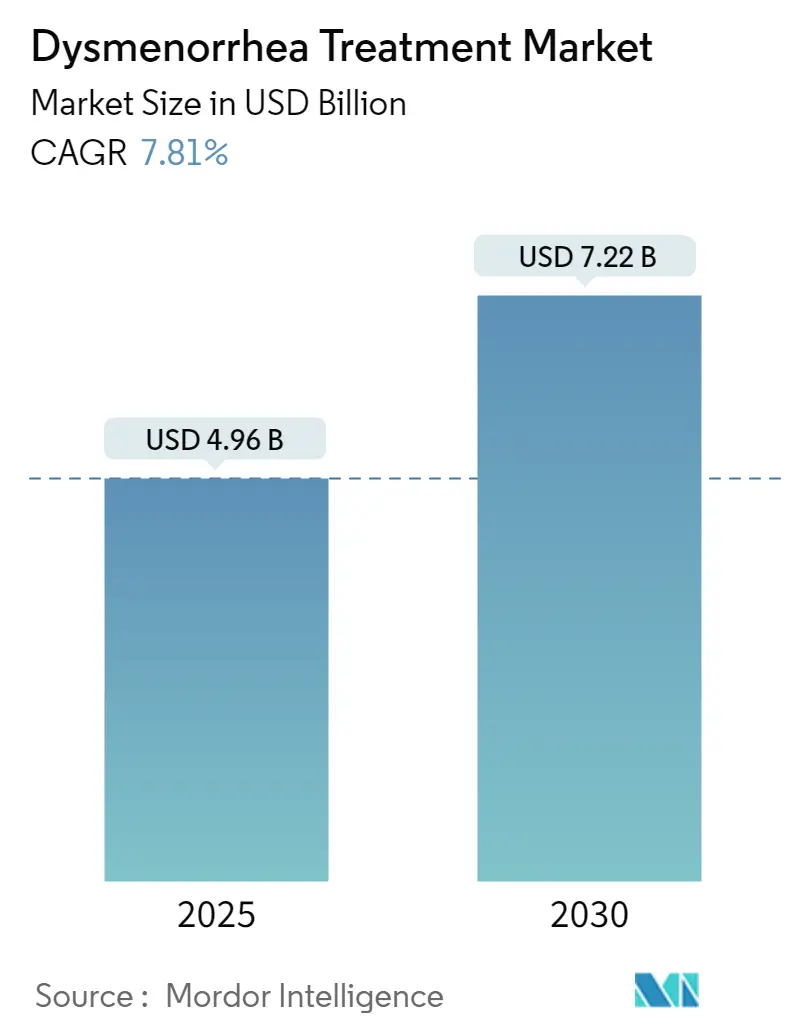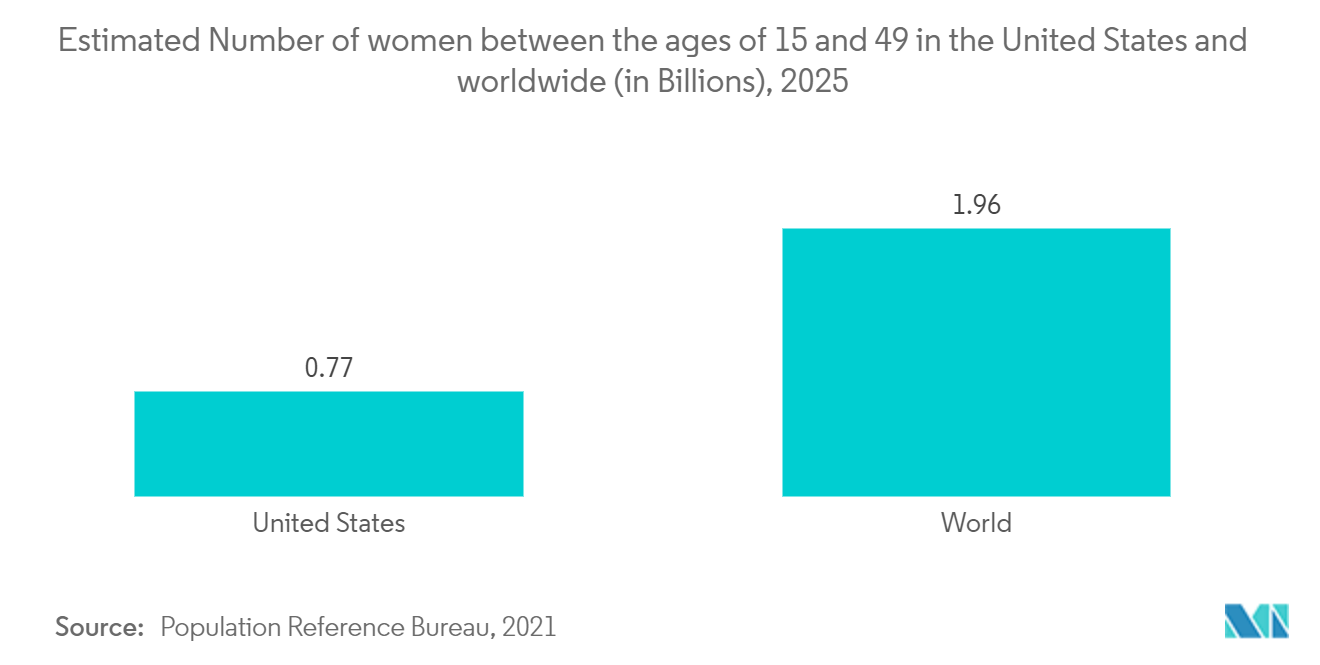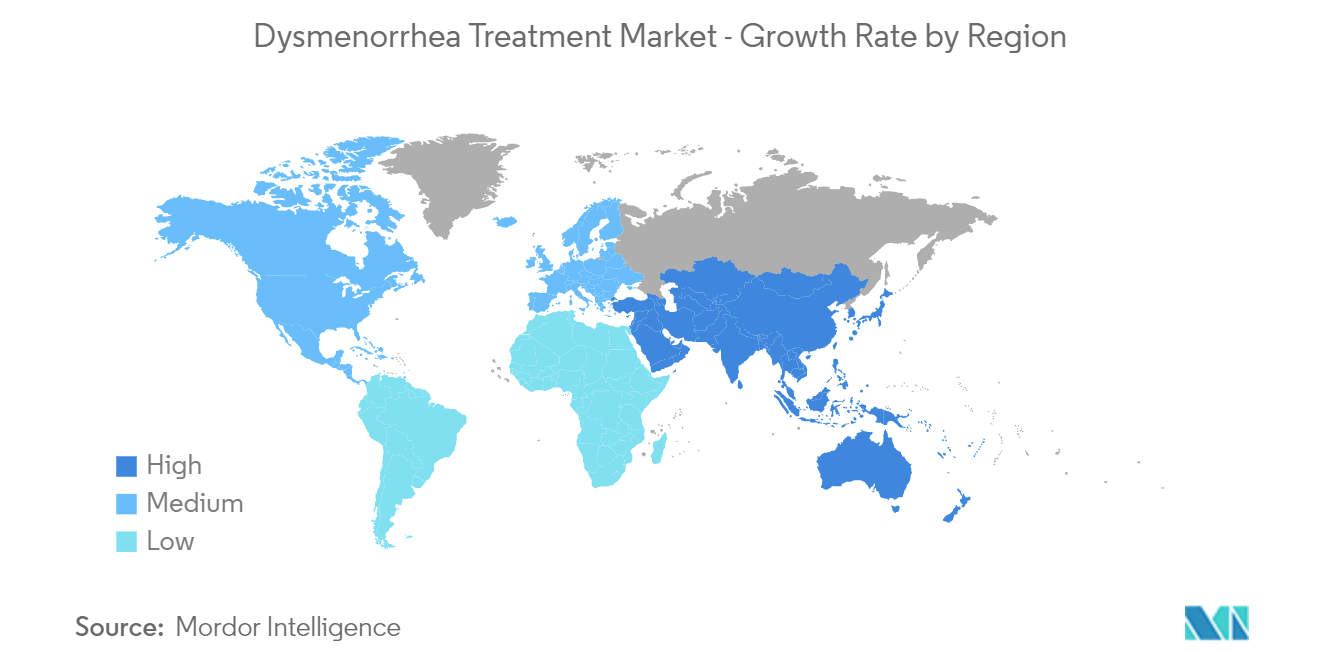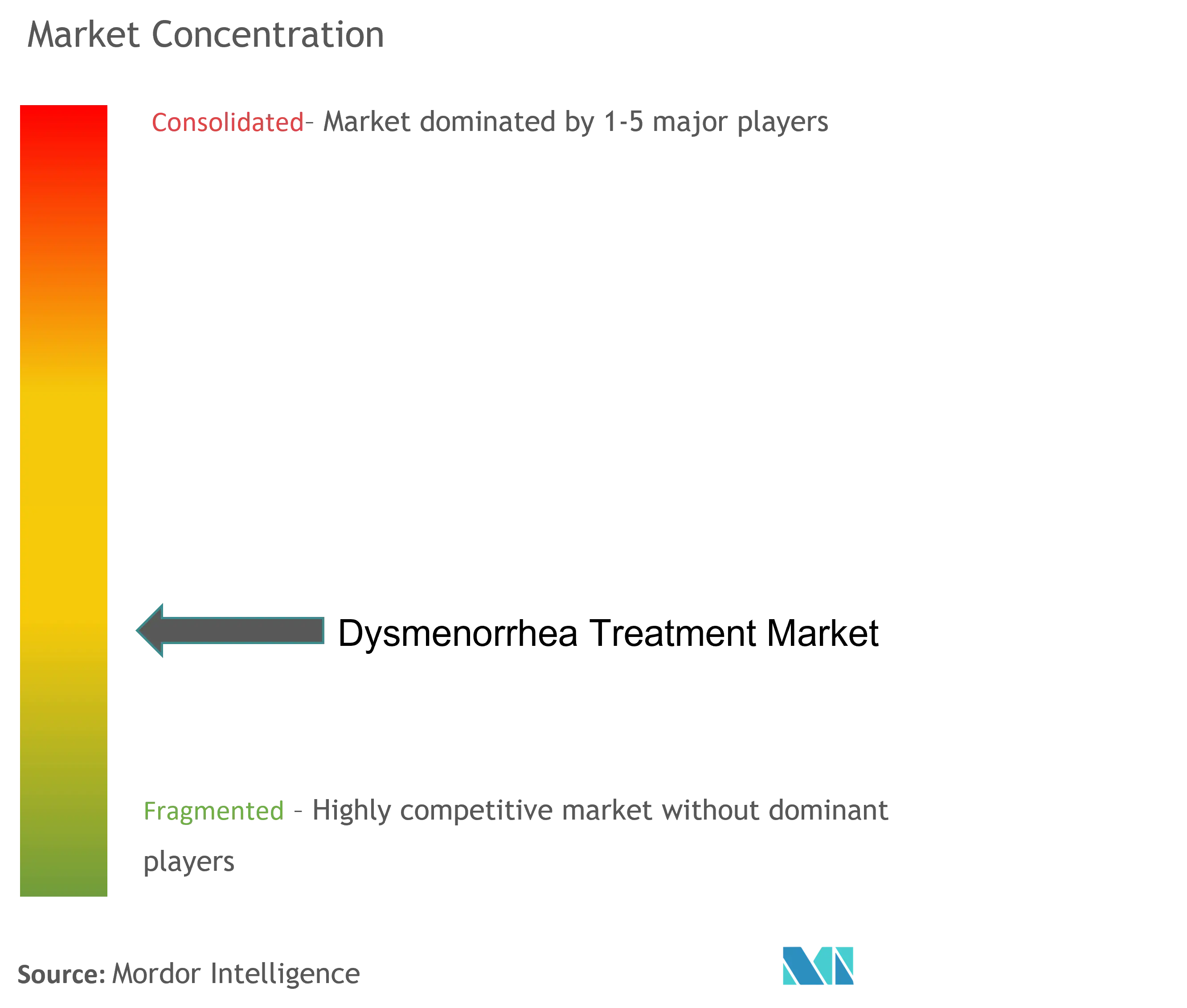Dysmenorrhea Treatment Market Size and Share

Dysmenorrhea Treatment Market Analysis by Mordor Intelligence
The Dysmenorrhea Treatment Market size is estimated at USD 4.96 billion in 2025, and is expected to reach USD 7.22 billion by 2030, at a CAGR of 7.81% during the forecast period (2025-2030).
COVID-19 was an unprecedented health concern affecting millions physically and mentally. The pandemic significantly impacted many people's mental health, resulting in loneliness, social isolation, financial strain, anxiety and fear of contracting the virus, and uncertainty for the future. It has been proven that periods of stress and psychological distress can affect a woman's menstrual health. Stressors can activate the hypothalamic-pituitary-gonadal (HPG) axis and alter the neuro-modulatory cascade that drives gonadotropin, releasing hormone (GnRH) regulation, which results in an irregular menstrual cycle. The changes in menstrual cycles lead to higher episodes of dysmenorrhea, significantly impacting the market.
According to a study published in March 2021 by Frontiers in Endocrinology, 46% of women reported a change in their menstrual cycle, with 30% of new dysmenorrhea cases since the pandemic began. Thus, COVID-19 had an impact on the dysmenorrhea treatment market significantly. Even after the pandemic, the market is expected to see a surge over the forecast period with increasing cases of dysmenorrhea and rising research and development.
Dysmenorrhea is commonly known as menstrual cramps, which affects women. The key factors attributed to driving the market growth are the increasing prevalence of dysmenorrhea among adolescent girls and rising cases of menstrual cramps due to genetic disorders. As per the study published in March 2022 by BMC Women's Health, the observed dysmenorrhea in the study; 1107 (92.3%) women had non-pathological dysmenorrhea (primary) while 92 (7.7%) women had pathological dysmenorrhea (secondary) respectively. Moreover, as per a study published in February 2021 by BMJ Open, dysmenorrhea was a common health problem among graduating university students. The prevalence of dysmenorrhea was 317 (51.5%) in Ethiopia. The educational status of the father, chocolate consumption (95%), daily breakfast intake (less than 5 days/week), irregular menstrual cycle, and positive family history of dysmenorrhea, had a statistically significant association with dysmenorrhea. Thus, the increasing burden of dysmenorrhea is expected to boost the growth of the market over the forecast period.
Moreover, increasing research and development for developing innovative drugs is expected to boost the growth of the market. As per a study published in July 2021 by the Journal of Clinical Medicine, various combinations of non-steroidal anti-inflammatory drugs (NSAIDs) and spasmolytics have been developed and tested, demonstrating a huge potential for future research to develop modern, effective combinations and search for new indications for the existing fixed-dose combination drugs for treating dysmenorrhea. Thus, research studies highlighting the potential of existing treatments for menstrual cramps and developing new drugs may drive the market.
However, side effects and complications associated with long-term treatment and lack of awareness about reproductive health in women are expected to restrain the market's growth during the forecast period.
Global Dysmenorrhea Treatment Market Trends and Insights
The Non-steroidal Anti-inflammatory Drugs Segment is Expected to Hold a Major Market Share in the Dysmenorrhea Treatment Market
Over-the-counter pain relievers, such as ibuprofen (Advil, Motrin IB, others) or naproxen sodium (Aleve), at regular doses starting the day before you expect your period to begin can help control the pain of cramps. Some of the US FDA-approved NSAIDs for the treatment of dysmenorrhea are diclofenac, ibuprofen, ketoprofen, meclofenamate, mefenamic acid, and naproxen.
According to an article published in the Women's Health Concern and British Menopause Society in December 2020, approximately 80% of dysmenorrhea women experience period pain at some stage in their lifetime. In 40% of women, period pain is accompanied by premenstrual symptoms, such as bloating, tender breasts, swollen stomach, lack of concentration, mood swings, clumsiness, and tiredness. Therefore, dysmenorrhea should be treated in its early days, which is expected to increase the usage of NSAIDs and drive the segment's growth.
Additionally, as per a research article by UpToDate last updated in February 2022, NSAIDs can more effectively treat dysmenorrhea-related pain. Approximately 80 trials reported that NSAIDs were more effective than placebo for patients with primary dysmenorrhea. In August 2022, Bayer demonstrated the data showing that a single maximum non-prescription dose of Aleve (naproxen sodium) provided more pain relief over 12 hours than acetaminophen for menstrual cramps due to primary dysmenorrhea. Thus, the high efficacies of NSAIDs are readily driving the adoption rate of NSAIDs, which may boost the market's growth.
Moreover, the prevalence of diseases such as endometriosis, which is the leading cause of secondary dysmenorrhea, is also rising globally. According to an article published in July 2021 by WebMD, endometriosis affects an estimated 1 in 10 women during their reproductive years, which is approximately 176 million women worldwide. This factor is expected to have a significant impact on the market's growth.

North America is Expected to Hold a Significant Share in the Market During the Forecast Period
North America is expected to hold a major market share in the dysmenorrhea treatment market. The United States is expected to contribute to this growth significantly due to the increasing incidence and prevalence of dysmenorrhea and awareness of dysmenorrhea among women. According to the statistics published in November 2020, Simmons Winter NHCS 12-Month, 31.31 million women in the US reported menstrual / period pain or pre-menstrual syndrome (PMS) in 2020.
Moreover, the launch of new products for treating the pain associated with primary and secondary dysmenorrhea is also driving the studied market. For instance, in May 2021, it was announced that the U.S. FDA approved Myfembree (relugolix 40 mg, estradiol 1 mg, and norethindrone acetate 0.5 mg), the first once-daily treatment for the management of heavy menstrual bleeding associated with uterine fibroids in premenopausal women, with a treatment duration of up to 24 months.

Competitive Landscape
The dysmenorrhea treatment market is competitive and consists of several major players. Some of the major players include Novartis AG, Bayer AG, Abbott Laboratories, F. Hoffmann-La Roche Ltd, Sanofi, Pfizer Inc., GlaxoSmithKline PLC, Focus Consumer Healthcare, Johnson & Johnson, and Alvogen.
Dysmenorrhea Treatment Industry Leaders
-
Novartis AG
-
Bayer AG
-
Abbott Laboratories
-
F. Hoffmann-La Roche Ltd
-
Sanofi
- *Disclaimer: Major Players sorted in no particular order

Recent Industry Developments
- In August 2022, Pfizer announced the FDA's approval of relugolix 40 mg, estradiol 1 mg, and norethindrone acetate 0.5 mg (MYFEMBREE) for managing moderate to severe pain associated with endometriosis in premenopausal women for up to 24 months.
- In August 2021, Dr. Reddy's Laboratories Ltd relaunched the over-the-counter (OTC) Naproxen Sodium Tablets USP, 220 mg, in the United States for minor pain, including menstrual cramps.
Global Dysmenorrhea Treatment Market Report Scope
As per the scope of the report, dysmenorrhea, also known as menstrual cramps, is cramping or throbbing pains in the lower abdomen. Most women experience dysmenorrhea just before and during their menstrual periods. The Dysmenorrhea Treatment Market is Segmented by Treatment Type (Non-steroidal Anti-inflammatory Drugs (NSAIDs) and Hormonal Therapy), Type (Primary Dysmenorrhea and Secondary Dysmenorrhea), and Geography (North America, Europe, Asia-Pacific, Middle-East and Africa, and South America). The market report also covers the estimated market sizes and trends for 17 countries across major regions globally. The report offers the value in USD million for the above segments.
| Non-steroidal Anti-inflammatory Drugs (NSAIDs) |
| Hormonal Therapy |
| Primary Dysmenorrhea |
| Secondary Dysmenorrhea |
| North America | United States |
| Canada | |
| Mexico | |
| Europe | Germany |
| United Kingdom | |
| France | |
| Italy | |
| Spain | |
| Rest of Europe | |
| Asia-Pacific | China |
| Japan | |
| India | |
| Australia | |
| South Korea | |
| Rest of Asia-Pacific | |
| Middle-East and Africa | GCC |
| South Africa | |
| Rest of Middle-East and Africa | |
| South America | Brazil |
| Argentina | |
| Rest of South America |
| By Treatment Type | Non-steroidal Anti-inflammatory Drugs (NSAIDs) | |
| Hormonal Therapy | ||
| By Type | Primary Dysmenorrhea | |
| Secondary Dysmenorrhea | ||
| Geography | North America | United States |
| Canada | ||
| Mexico | ||
| Europe | Germany | |
| United Kingdom | ||
| France | ||
| Italy | ||
| Spain | ||
| Rest of Europe | ||
| Asia-Pacific | China | |
| Japan | ||
| India | ||
| Australia | ||
| South Korea | ||
| Rest of Asia-Pacific | ||
| Middle-East and Africa | GCC | |
| South Africa | ||
| Rest of Middle-East and Africa | ||
| South America | Brazil | |
| Argentina | ||
| Rest of South America | ||
Key Questions Answered in the Report
How big is the Dysmenorrhea Treatment Market?
The Dysmenorrhea Treatment Market size is expected to reach USD 4.96 billion in 2025 and grow at a CAGR of 7.81% to reach USD 7.22 billion by 2030.
What is the current Dysmenorrhea Treatment Market size?
In 2025, the Dysmenorrhea Treatment Market size is expected to reach USD 4.96 billion.
Who are the key players in Dysmenorrhea Treatment Market?
Novartis AG, Bayer AG, Abbott Laboratories, F. Hoffmann-La Roche Ltd and Sanofi are the major companies operating in the Dysmenorrhea Treatment Market.
Which is the fastest growing region in Dysmenorrhea Treatment Market?
Asia Pacific is estimated to grow at the highest CAGR over the forecast period (2025-2030).
Which region has the biggest share in Dysmenorrhea Treatment Market?
In 2025, the North America accounts for the largest market share in Dysmenorrhea Treatment Market.
What years does this Dysmenorrhea Treatment Market cover, and what was the market size in 2024?
In 2024, the Dysmenorrhea Treatment Market size was estimated at USD 4.57 billion. The report covers the Dysmenorrhea Treatment Market historical market size for years: 2019, 2020, 2021, 2022, 2023 and 2024. The report also forecasts the Dysmenorrhea Treatment Market size for years: 2025, 2026, 2027, 2028, 2029 and 2030.
Page last updated on:
Dysmenorrhea Treatment Market Report
Statistics for the 2025 Dysmenorrhea Treatment market share, size and revenue growth rate, created by Mordor Intelligence™ Industry Reports. Dysmenorrhea Treatment analysis includes a market forecast outlook for 2025 to 2030 and historical overview. Get a sample of this industry analysis as a free report PDF download.



